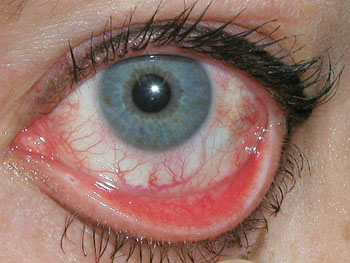Of all the modern remedies we are encouraged to add to our daily regimens, none has been pitched quite so emphatically as the omega-3 fish oils.1 Among the many claims of therapeutic benefit attributed to these “fats of the sea” are improvements in visual health, from reductions in dry eye and allergy symptoms to improved retinal and macular health.
|
This month we’ll look at the biology behind fish oils, consider the impact of these compounds on ocular health and examine how studies aimed at understanding omega-3’s effects have led to new potential therapies for a host of ocular conditions.
The membranes of cells throughout the body are composed of a mixture of lipids, including various phospholipids, cholesterol and smaller amounts of other fat-soluble compounds. Phospholipid molecules are constructed from a variable head group (choline, serine or inositol, for example) linked with two fatty acid molecules attached side by side. A fatty acid is nothing more than a carboxylic acid attached to a long, repeating-carbon chain (typically 16 to 24 carbons) connected by either single, saturated bonds or double, unsaturated bonds. Fatty acids from natural sources, either from plants or animals, are typically polyunsaturated fatty acids; that means they have three or more double bonds. While this may seem like minutiae, PUFAs are further classified by the extent and position of the double bonds, factors that have significant effects on the properties and functions of these fat molecules. Most PUFAs from plant sources are omega-6 oils, which means their first double bond is at the sixth from the last (the omega) carbon in the chain; in contrast, the oils derived from cold water species of fish are omega-3 oils, and this difference is critical because of the signaling molecules derived from these fatty acid precursors.
Several key omega-3 PUFAs include eicosapentaenoic acid, docosahexaenoic acid, and the more abundant, plant-derived α-linolenic acid.2 Humans, it seems, are deficient in the enzymes required to synthesize omega-3 PUFAs, and so their supply in the body is often dictated by dietary intake.2,3 The more complex omega-3s DHA and EPA can be formed from the more abundant ALA, but it appears that this process in an inefficient one. There may be individual differences in our bodies’ ability to synthesize DHA or EPA, but whatever the extent of that ability, it’s clear that most people can achieve significant health benefits from dietary supplementation of these critical nutrients.
Uses and Benefits
We know of several ways in which omega-3 fats act to elicit their beneficial effects.
At a basic, chemical level they can compete with other fatty acids, including monosaturated fatty acids, for incorporation into membrane phospholipids. By reducing the amount of monosaturated fats (including trans fats) incorporated into cell membranes they can optimize the membrane properties and cellular functions.
One example of this optimization comes from studies of lipid rafts, which are specialized regions of cell membranes where signaling molecules, including trans-membrane receptors, signaling kinases and adhesion molecules are organized so that cellular messages are efficiently transmitted.4
Such rafts, comprised of a mixture of proteins, lipoproteins, specialized lipids and cholesterol, are found in all cells but are particularly critical to cells in the nervous, immune and hematopoietic systems. We know that both raft movement and raft-raft association is a dynamic process, and studies have shown that unsaturated fats, particularly DHA, may be important in facilitating this movement.
|
The benefits of dietary omega-3 fats were first recognized in cardiovascular studies that showed a strong association between dietary fish intake and reduced risk of cardiovascular disease.3,5 While there is nutritional value to eating fish beyond these fats alone, subsequent studies have made it clear that omega-3 FAs play an essential role in the benefits derived from eating fish.
At a cellular level, both DHA and EPA have dramatic effects on cardiovascular excitability, in large part because of their ability to modulate cardiac ion channels responsible for contractility. These effects are likely to be part, but not all, of the explanation for the enhancements in cardiovascular health. Another benefit is seen in studies of the relationship between lipids and lipid signaling in vascular homeostasis. There is strong evidence that diets enriched in fats such as DHA and EPA can reduce the pathological neovascularization that accompanies diabetic retinopathy, age-related macular degeneration and many forms of cancer.6,7 Some of the potential mechanisms underlying this effect are addressed below.
Some of the clearest benefits of dietary omega-3 fats are their effects on the visual cascade and on the maintenance of optimal retinal signaling. Studies by Burton Litman, PhD, and colleagues at the National Institute on Alcohol Abuse and Alcoholism at the National Institutes of Health demonstrated that, in both model membranes and in rat outer rod segments, the efficiency of light-driven rhodopsin activation (and, therefore, visual signaling) was dependent on the amount of omega-3 phospholipid (DHA) present in rod outer segment membranes.8,9 They showed that replacing dietary DHA with an omega-6 analog led to an 80-percent decrease in the DHA content of rod outer segment lipids, and a three- to fivefold decrease in the phosphodiesterase enzyme activity that couples photon absorption to electrical signaling.
Other cells of the nervous system, particularly the central nervous system, actively sequester DHA so their cell membranes have a higher concentration of this omega-3 FA than most tissues; in nerve cells the percentage of DHA can be as high as 50 percent, while in other tissues it is rarely above 5 percent.3,5 Thus the role of DHA in visual signaling may be one instance of a more widespread functional role.
An early step in many intracellular signaling pathways is activation of phospholipases such as phosphatidic acid-2.2 Most phospholipases can release any free fatty acids from their phosphate-containing head group, so both omega-6 and omega-3 forms can be generated. When omega-6 fats such as arachidonic acid are liberated, they become available as substrates for lipoxygenases and cyclo-oxygenases, generating pro-inflammatory leukotrienes or prostaglandins. There is abundant evidence for a role of these signaling molecules in ocular inflammation.10,11
In this respect, omega-3 fats can act via mass action to limit inflammation, since dietary omega-3 and omega-6 fats compete for the same space in the phospholipid pool. These interactions with the pathways of cellular signaling provide clues to what might be the most significant roles of the omega-3 fats: building blocks of a unique signaling pathway outlined below.
Omega-3 Fats and Resolvins
While the majority of omega-3 fats are bound in an esterified, phospholipid form, free fatty acids are also present at low concentrations, with or without action of phospholipases. The free acids, especially long chain forms such as DHA, are natural ligands for several gene regulatory elements, including retinoid receptors and PPARα.12 These transcriptional effects are specific for omega-3 FAs, and they seem to play an important role in regulating expression of enzymes associated with lipid metabolism. In addition, activation of PPARα may also be part of the anti-angiogenic effects described earlier.
|
A second variety of resolvin, RvD1, is formed from DHA by a series of lipoxygenase-catalyzed reactions that’s even more complex than the multi-step synthesis of RvE1. In both cases, expression of one or more of the enzymes involved is induced as part of the inflammatory cascade, further demonstrating their endogenous role as mediators of inflammatory resolution. Other DHA-derived resolvins are particularly important in resolution of peripheral and central nervous system pain, and in addition to these actions as potent anti-inflammatories, both RvE1 and RvD1 have significant anti-nociceptive action.16
It’s not difficult to understand the reason why omega-3 fats have such an important role in maintaining good ocular health; in addition to their role in visual transduction and in attenuating pathologic neovascularization, several studies examining pain and inflammation have implicated resolvins as keys players in the ocular healing process.
In a mouse model of dry eye, for example, RvE1 significantly reduced the corneal staining associated with the disease.17 In another study, increases in goblet cell secretion in vitro were induced by leukotrienes and by prostaglandin D2, similar to the response evoked by inflammatory stimuli in vivo. In this same study, these increases were blocked by resolvin RvE1 and RvD1; in a sense these experiments recapitulated the time course of the inflammatory response, from inflammation-induced hypersecretion to resolution and return to basal secretory levels.18
Efforts to test resolving efficacy in clinical trials are also under way: Celtic Therapeutics recently completed a Phase II study (conducted by Ora Inc.) of a RvE1 prodrug, RX-10045, as a therapy for signs and symptoms of dry-eye disease. It doesn’t take too much imagination to see that the potential for resolvin-based drugs in ocular disease is significant. And while current focus is on RvE1 and RvD1, other resolvins, including RvE2 or AT-RvD1 may also hold promise as therapeutic entities.
By almost any reasonable standard, fish oils would appear to have achieved the status of dietary supplement sine qua non. Despite this, we have much work to do before we have a comprehensive grasp of their pleiotropic actions. Yet even at this early stage of pharmaceutical development, it’s clear that a better understanding of the biology of omega-3 fats is a sure gateway to the discovery of new therapies and new approaches for treating a host of ocular conditions. REVIEW
Dr. Abelson is a clinical professor of ophthalmology at Harvard Medical School and Senior Clinical Scientist at the Schepens Eye Research Institute. Dr. McLaughlin is a medical writer at Ora Inc., in Andover.
1. Hayden T. Getting to know nutriceuticals. Sci Amer 2007;297:38-44.
2. Jump DB. The biochemistry of n-3 polyunsaturated fatty acids. J Biol Chem 2002;277:8755-8758.
3. Swanson D, Block R, Mousa SA. Omega-3 fatty acids EPA and DHA: Health benefits throughout life. Adv Nutr 2012;3:1-7.
4. Fessler MB, Parks JS. Intracellular lipid flux and membrane microdomains as organizing principles in inflammatory cell signaling. J Immunol 2011;187:1529-35.
5. Deckelbaum RJ, Torrejon C. The omega-3 fatty acid nutritional landscape: Health benefits and sources. J Nutr 2012;Feb 8. [Epub ahead of print]
6. Sapieha P, Stahl A, Chen J, et al. 5-Lipoxygenase metabolite 4-HDHA is a mediator of the antiangiogenic effect of omega-3 polyunsaturated fatty acids. Sci Transl Med 2011;3:69:69ra12.
7. Connor KM, SanGiovanni JP, Lofqvist C, et al. Increased dietary intake of omega-3-polyunsaturated fatty acids reduces pathological retinal angiogenesis. Nat Med 2007;13:868-873.
8. Litman BJ, Niu SL, Polozova A, Mitchell DC. The role of docosahexaenoic acid containing phospholipids in modulating G protein-coupled signaling pathways: Visual transduction. J Mol Neurosci 2001;16:237-42.
9. Niu SL, Mitchell DC, Lim SY, Wen ZM, Kim HY, Salem N Jr, Litman BJ. Reduced G protein-coupled signaling efficiency in retinal rod outer segments in response to n-3 fatty acid deficiency. J Biol Chem 2004;279:31098-104.
10. Udell IJ, Abelson MB. Chemical mediators of inflammation. Int Ophthalmol Clin 1983;23:1:15-26.
11. Abelson MB, Butrus SI, Kliman GH, Larson DL, Corey EJ, Smith LM. Topical arachidonic acid: A model for screening anti-inflammatory agents. J Ocul Pharmacol 1987;3:63-75.
12. Mozaffarian D, Wu JH. (n-3) Fatty Acids and Cardiovascular Health: Are Effects of EPA and DHA Shared or Complementary? J Nutr 2012;Jan 25. [Epub ahead of print]
13. Serhan, CN. Krishnamoorthy S, Recchiuti A, Chiang N. Novel anti-inflammatory, pro-resolving mediators and their receptors. Curr Topics Med Chem 2011;11:6:629-647.
14. Fredman G, Serhan CN. Specialized proresolving mediator targets for RvE1 and RvD1 in peripheral blood and mechanisms of resolution. Biochem J 2011;437:2:185-197.
15. Groeger AL, Cipollina C, Cole MP, et al. Cyclooxygenase-2 generates anti-inflammatory mediators from omega-3 fatty acids. Nat Chem Biol 2010;6:433-440.
16. Ji R-R, Xu Z-Z, Strichartz G, Serhan CN. Emerging roles of resolvins in the resolution of inflammation and pain. Trends Neurosci 2011;34:599-609.
17. de Paiva CS, Schwartz CE, Gjörstrup P, Pflugfelder SC. Resolvin E1 (RX-10001) reduces corneal epithelial barrier disruption and protects against goblet cell loss in a murine model of dry eye. Cornea 2012;31:1–5.
18. Dartt DA, Hodges RR, Li D, Shatos MA, Lashkari K, Serhan CN. Conjunctival goblet cell secretion stimulated by leukotrienes is reduced by resolvins D1 and E1 to promote resolution of inflammation. J Immunol 2011;186:4455-66.






